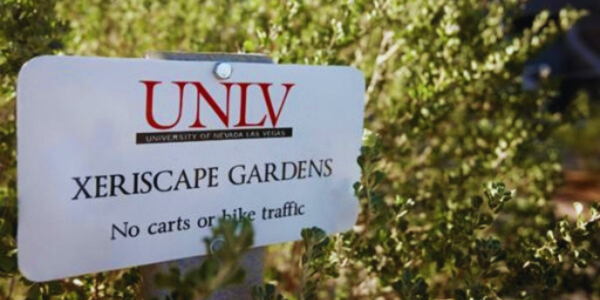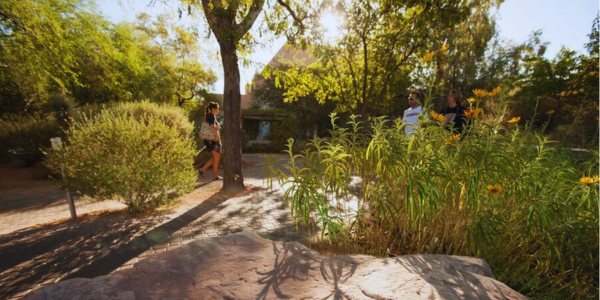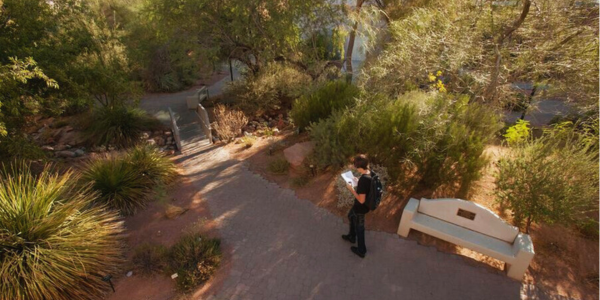
Discover the sustainable beauty of the Baepler Xeric Garden at UNLV.
Nestled at the entrance of the Marjorie Barrick Museum, the Donald H. Baepler Xeric Garden at UNLV stands as a testament to the harmonious combination of drought-tolerant plants and an efficient irrigation system. Not only does it save water, but it also creates a visually captivating landscape. As the first large-scale demonstration garden in the Las Vegas Valley, it holds a special place as a tranquil retreat in the heart of campus, showcasing the remarkable beauty that thrives in arid climates.

What is an Xeric Garden?
A xeric garden is a type of garden that uses plants that can survive with little water. The word “xeric” comes from the Greek word “xerox,” which means “dry.” Xeric gardens are also known as xeriscapes, which means “dry landscapes.” They are ideal for arid climates, such as the Las Vegas Valley, where water is scarce and precious.
Xeric gardens are not only water-efficient but also visually appealing. They showcase the diversity and beauty of plants that can thrive in dry conditions. You’ll find plants with different shapes, colors, textures, and flowers. Some of the plants you’ll see in the Baepler Xeric Garden are blue yucca, agave, eucalyptus, jojoba, and creosote bush.
The History and Design of the Baepler Xeric Garden
The Baepler Xeric Garden was the first large-scale demonstration garden in the Las Vegas Valley. It was completed in 1988, thanks to the vision of former UNLV facilities manager Dennis Swartzell and the support of former UNLV president and higher education chancellor Donald Baepler. The garden was named after Baepler, who quietly championed the cause of creating a campus greenhouse.
The garden was designed by Jack Zunino, a renowned local landscape architect who also designed other xeric gardens in the valley, such as the Las Vegas Premium Outlets, the World Market Center, and the Southwest Gas Demonstration Gardens. Zunino’s design covers an area of more than 9,000 square feet, featuring paved pathways, benches, covered ramadas, and wooden bridges. The garden also has a pool and a wall that provides water for migratory and local birds. Sandstone boulders from the base of Mt. Potosi add to the garden’s natural charm.
The garden is located at the entrance of the Marjorie Barrick Museum, which houses exhibits of natural history and art. The garden also extends the natural beauty of the Harry Reid Center for Environmental Studies, which researches environmental issues. The garden’s plant collection represents a diverse range of regions, including Australia, South America, Mexico, the Mediterranean, and the four desert regions of North America.

The Benefits and Uses of the Baepler Xeric Garden
The Baepler Xeric Garden is not only a beautiful attraction but also a valuable resource. It serves as a living laboratory for students and researchers who study landscape architecture, biology, and ornamental horticulture. It also serves as a source of inspiration and education for anyone who wants to create their own xeric garden. The garden demonstrates how drought-tolerant plants and efficient irrigation systems can result in sustainable and aesthetically pleasing landscapes.
The garden is also a peaceful place that invites visitors to take a break, reflect, and immerse themselves in its tranquility. The Klinkhammer Bird Viewing Ramada, located at the garden’s north end, is a popular spot for visitors and campus walking tours. You can also enjoy the live music events and shows that are hosted at the garden throughout the year.
How to Visit the Baepler Xeric Garden
The Baepler Xeric Garden is open to the public and free of charge. You can visit the garden anytime during the day, but the best time to visit is in the morning or evening when the temperature is cooler and the light is softer. You can also visit the Barrick Museum and the Harry Reid Center, which are adjacent to the garden.
Location: UNLV Desert Demonstration Gardens
Address: 4505 S. Maryland Parkway, Las Vegas, NV 89119
Phone: (702) 895-3392
Website: unlv.edu
Discover More Botanical Desert Beauty
Do you want to visit some other demonstration gardens? If so, you can check out the Acacia Demonstration Gardens and the North Las Vegas Demonstration Gardens. Both offer additional and varied desert planting and conservation ideas.